Magnetic Fields
Magnetic Field Definition
- A magnetic field is a field of force that is created either by:
- Moving electric charge
- Permanent magnets
- Permanent magnets are materials that produce a magnetic field
- A stationary charge will not produce a magnetic field
- A magnetic field is sometimes referred to as a B-field
- A magnetic field is created around a current carrying wire due to the movement of electrons
- Although magnetic fields are invisible, they can be observed by the force that pulls on magnetic materials, such as iron or the movement of a needle in a plotting compass
Representing Magnetic Fields
- Magnetic fields are represented by magnetic field lines
- These can be shown using iron filings or plotting compasses
- Field lines are best represented on bar magnets, which consist of a north pole on one end and south pole on the other
- The magnetic field is produced on a bar magnet by the movement of electrons within the atoms of the magnet
- This is a result of the electrons circulating around the atoms, representing a tiny current and hence setting up a magnetic field
- The direction of a magnetic field on a bar magnet is always from north to south
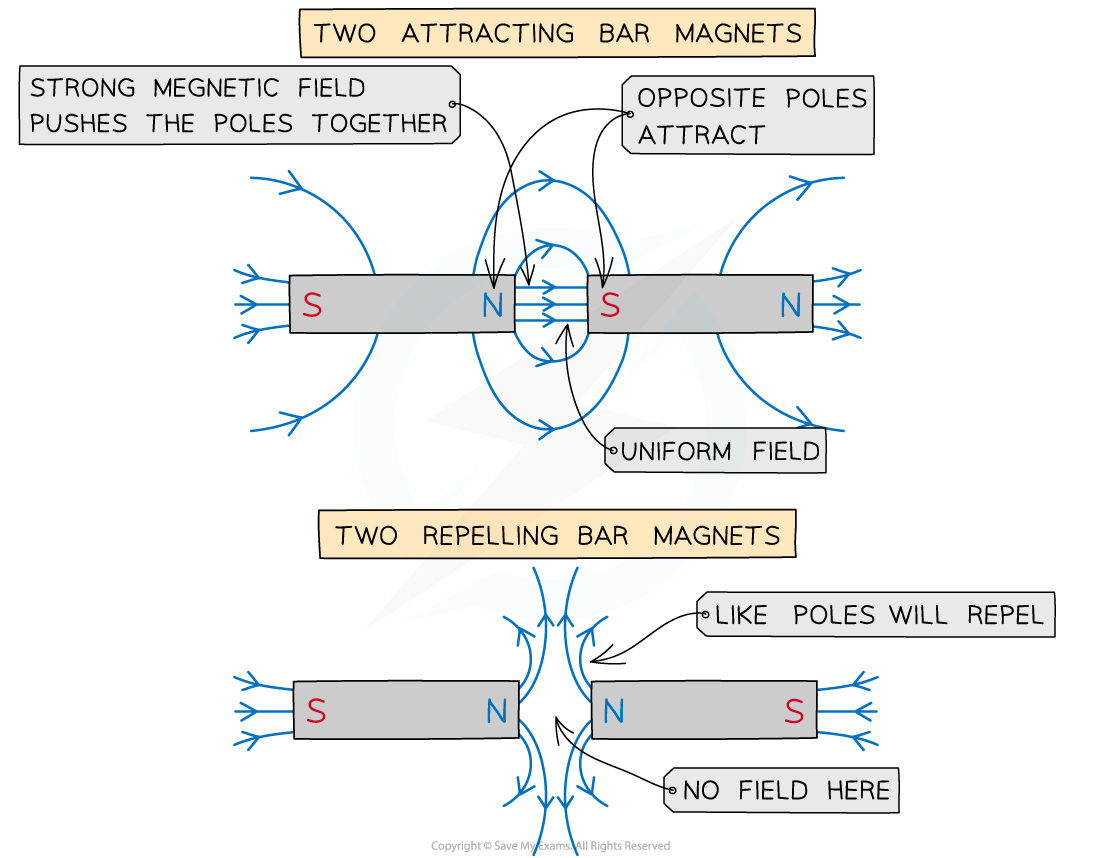
Magnetic field lines are directed from the north pole to the south pole
- When two bar magnets are pushed together, they either attract or repel each other:
- Two like poles (north and north or south and south) repel each other
- Two opposite poles (north and south) attract each other
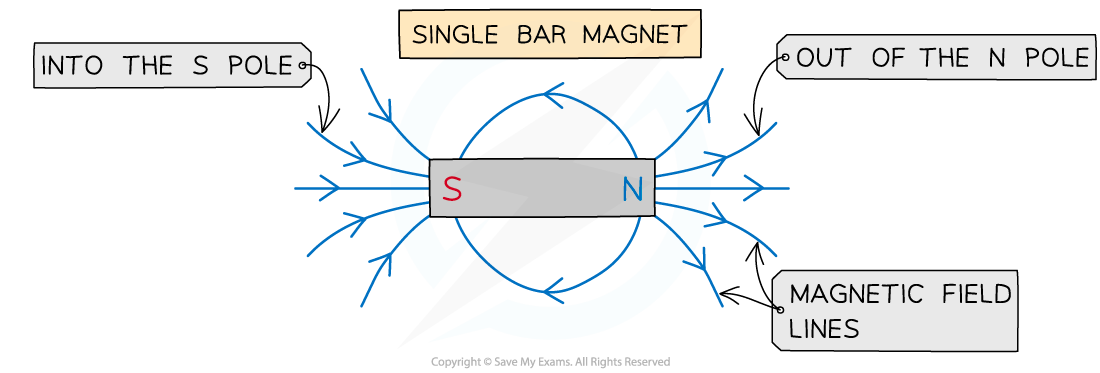
Two opposite poles attract each other and two like poles repel each other
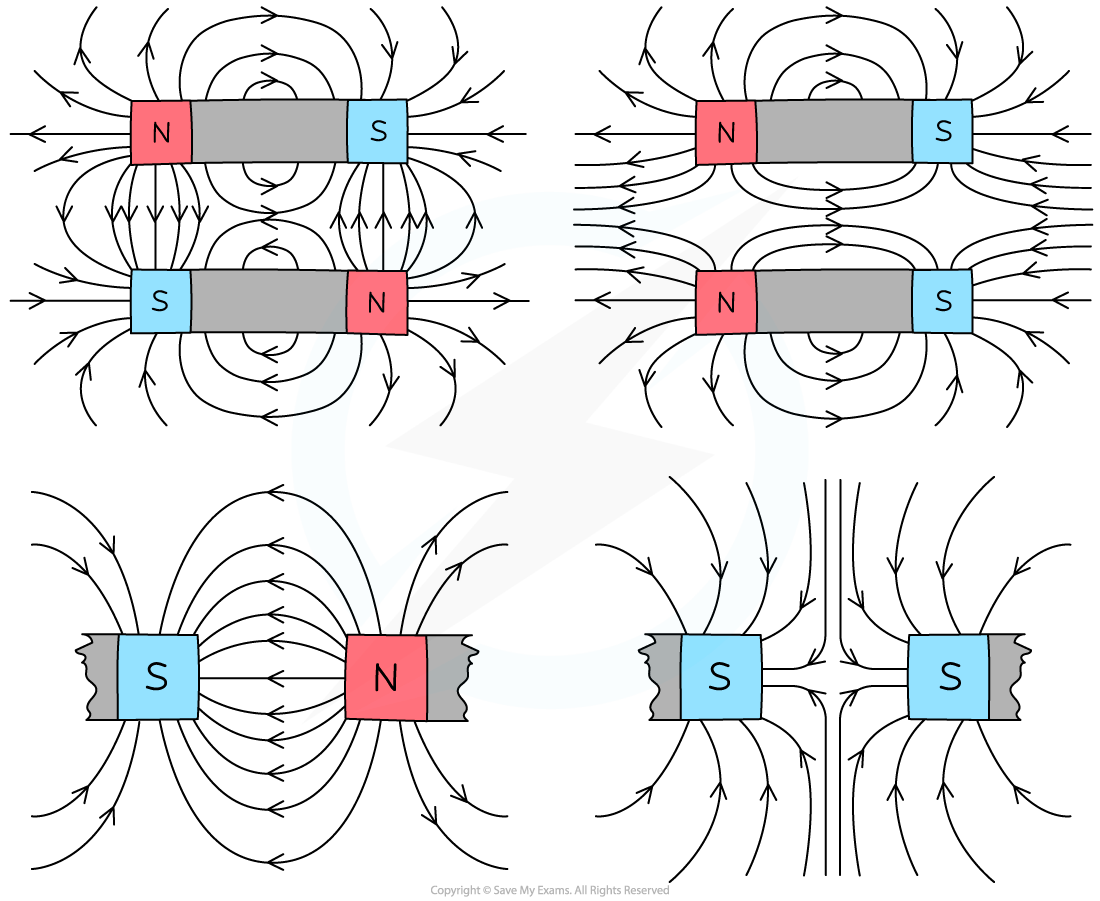
Magnetic field lines between two bar magnets
- The key aspects of drawing magnetic field lines:
- The lines come out from the north poles and into the south poles
- The direction of the field line shows the direction of the force that a free magnetic north pole would experience at that point
- The field lines are stronger the closer the lines are together
- The field lines are weaker the further apart the lines are
- Magnetic field lines never cross since the magnetic field is unique at any point
- Magnetic field lines are continuous
- A uniform magnetic field is where the magnetic field strength is the same at all points
- This is represented by equally spaced parallel lines, just like electric fields
- The direction of the magnetic field into or out of the page in 3D is represented by the following symbols:
- Dots (sometimes with a circle around them) represent the magnetic field directed out of the plane of the page
- Crosses represent the magnetic field directed into the plane of the page
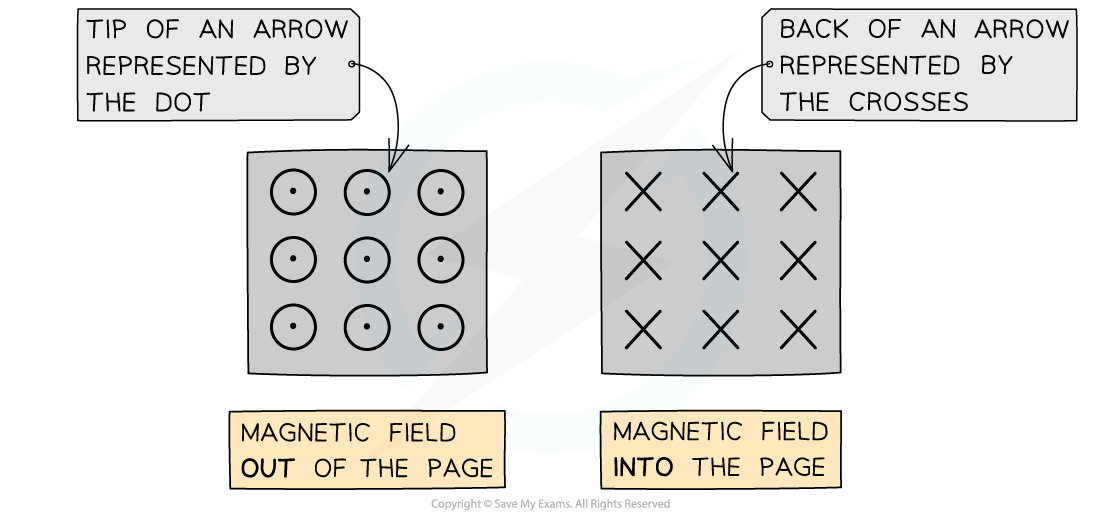
The magnetic field into or out of the page is represented by circles with dots or crosses
Exam Tip
The best way to remember which way around to draw magnetic fields in 3D is by imagining an arrow coming towards or away from you
- When the head of an arrow is coming towards you, you see the tip as a dot representing the arrow coming ‘out’ of the page
- When an arrow is travelling away from you, you see the cross at the back of the arrow representing the arrow going ‘into’ the page
Right Hand Rule
Magnetic Fields in Wires, Coils & Solenoids
- Magnetic field patterns are not only observed around bar magnets, magnetic fields are formed wherever current is flowing, such as in:
- Long straight wires
- Long solenoids
- Flat circular coils
Field Lines in a Current-Carrying Wire
- Magnetic field lines in a current carrying wire are circular rings, centered on the wire
- The field lines are strongest near the wire and become further part away from the wire
- Reversing the current reverses the direction of the field
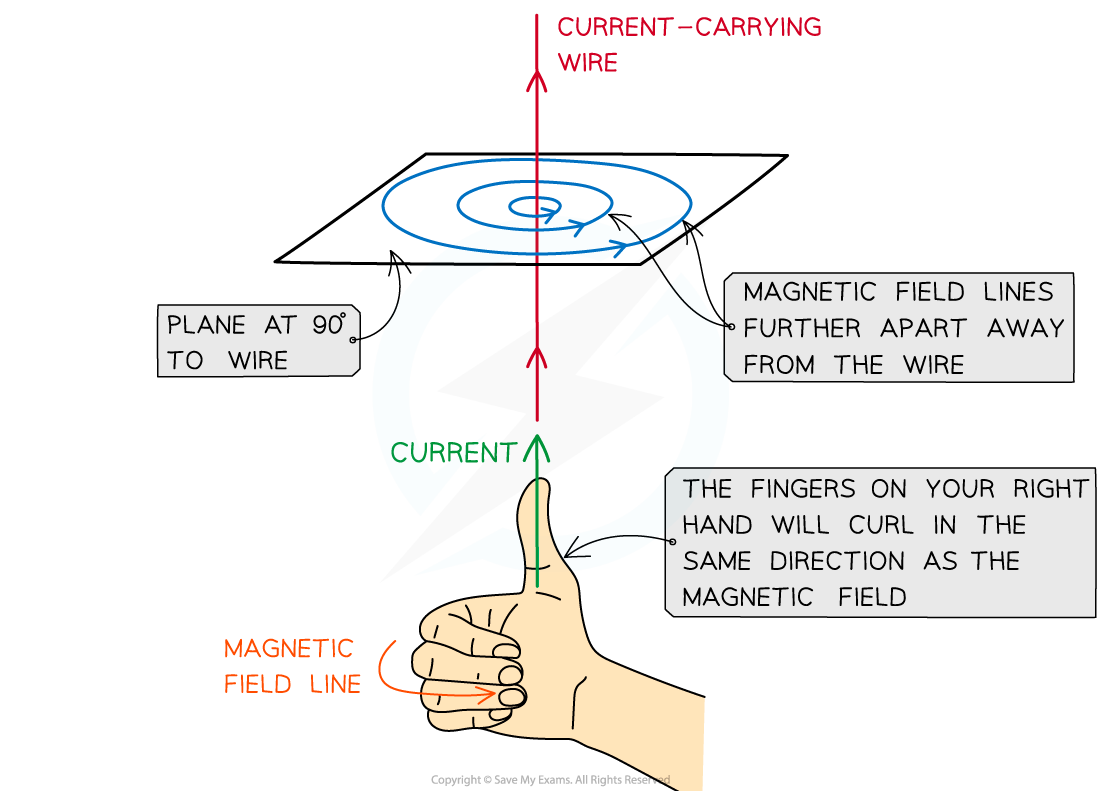
The direction of magnetic field lines on a current carrying wire can be determined by the right hand thumb rule
- The field lines are clockwise or anticlockwise around the wire, depending on the direction of the current
- The direction of the magnetic field is determined by Maxwell’s right hand screw rule
- This is determined by pointing the right-hand thumb in the direction of the current in the wire and curling the fingers onto the palm
- The direction of the curled fingers represents the direction of the magnetic field around the wire
- For example, if the current is travelling vertically upwards, the magnetic field lines will be directed anticlockwise, as seen from directly above the wire
- Note: the direction of the current is taken to be the conventional current ie. from positive to negative, not the direction of electron flow
Field Lines in a Solenoid
- As seen from a current carrying wire, an electric current produces a magnetic field
- An electromagnetic makes use of this by using a coil of wire called a solenoid which concentrates the magnetic field
- One ends becomes a north pole and the other the south pole
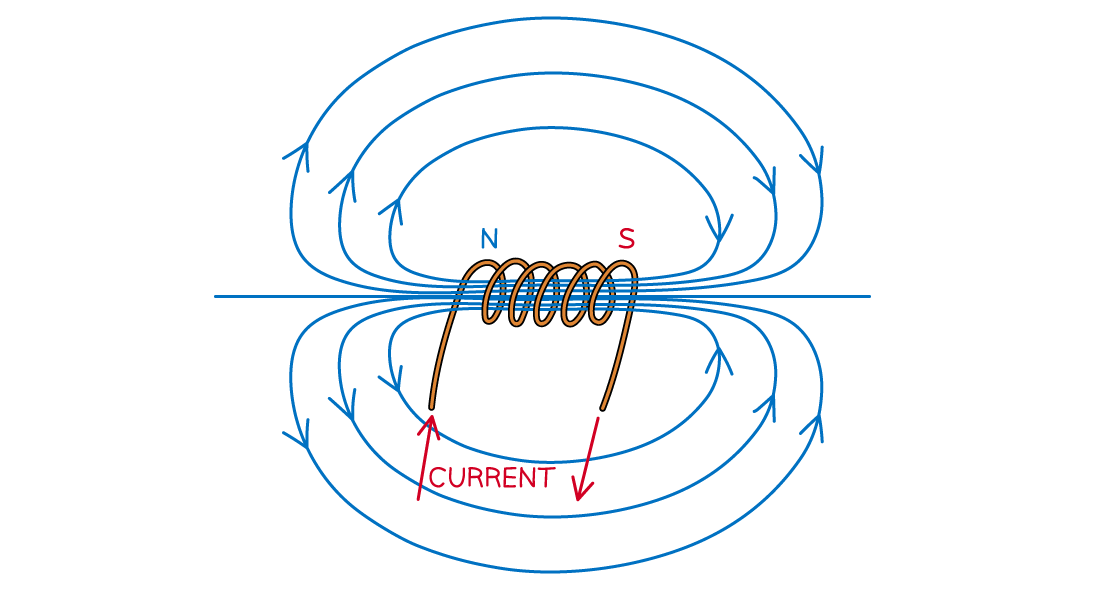
Magnetic field lines around a solenoid are similar to a bar magnet
- Therefore, the magnetic field lines around a solenoid are very similar to a bar magnet
- The field lines emerge from the north pole
- The field lines return to the south pole
- Which is the north or south pole depends on the direction of the current
- This is found by the right-hand grip rule
- This involves gripping the electromagnet so the fingers represent the direction of the current flow of the wire
- The thumb points in the direction of the field lines inside the coil, or in other words, point towards the electromagnet’s north pole
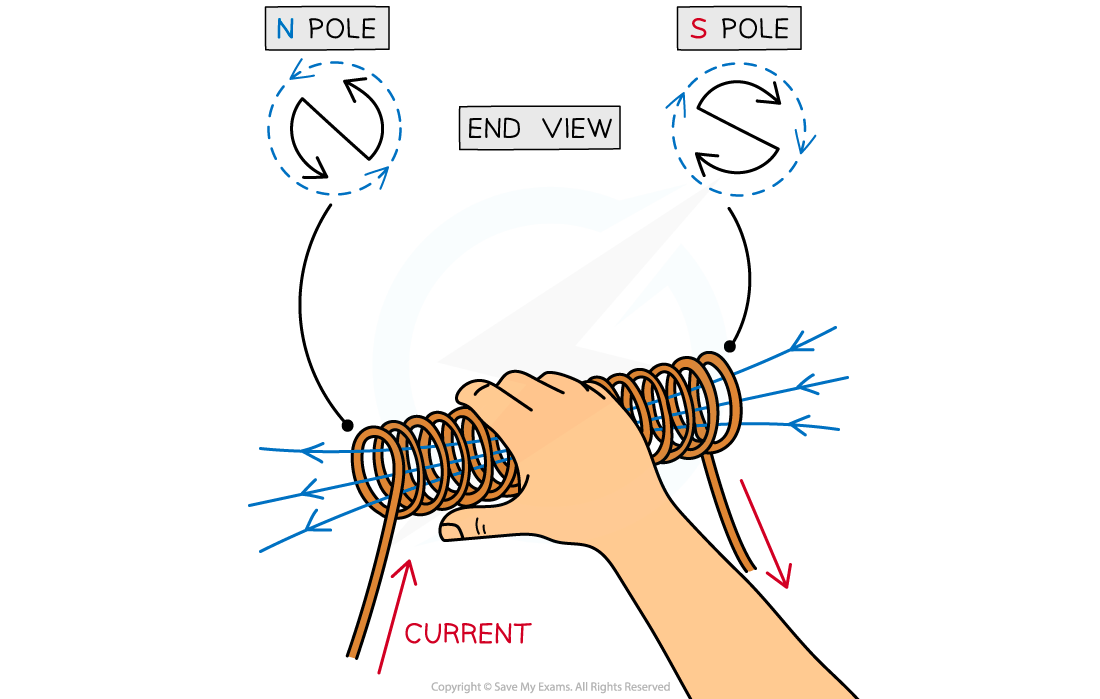
Poles of a Solenoid
Field Lines in a Flat Circular Coil
- A flat circular coil is equal to one of the coils of a solenoid
- The field lines will emerge through one side of the circle (north pole) and leave the other (south pole)
- As before, the direction of the north and south pole depends on the direction of the current
- This can be determined by using the right-hand thumb rule
- It is easier to find the direction of the magnetic field on the straight part of the circular coil to determine which direction the field lines are passing through
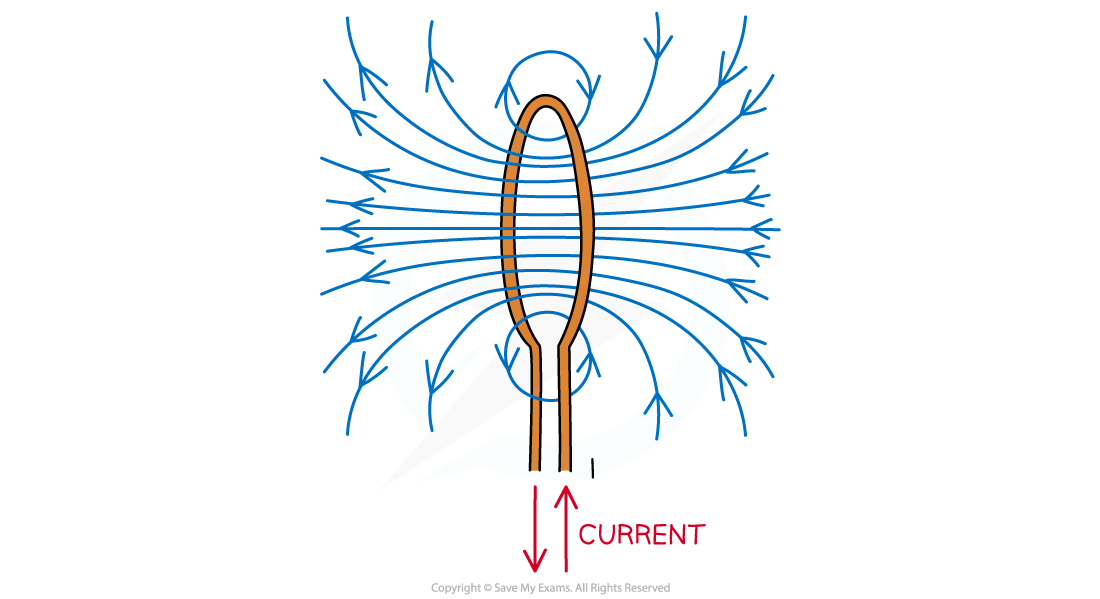
Magnetic field lines of a single circular coil are added up together to make to make the field lines of a solenoid
Worked Example
The current in a long, straight vertical wire is in the direction XY, as shown in the diagram. Sketch the pattern of the magnetic flux in the horizontal plane ABCD due to the current-carrying wire. Draw at least four flux lines.
Sketch the pattern of the magnetic flux in the horizontal plane ABCD due to the current-carrying wire. Draw at least four flux lines.

✓ Concentric circles
✓ Increasing separation between each circle
✓ Arrows drawn in anticlockwise direction
Exam Tip
Remember to draw the arrows showing the direction of the field lines on every single field line you draw. Also, ensure that in a uniform magnetic field, the field lines are equally spaced.
